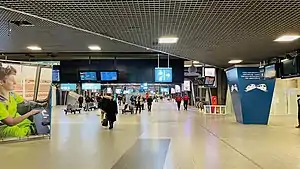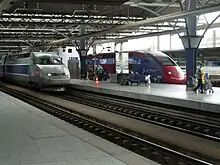Brussels-South railway station
Brussels-South railway station (French: Gare de Bruxelles-Midi, Dutch: Station Brussel-Zuid, IATA code: ZYR), officially Brussels-South (French: Bruxelles-Midi, Dutch: Brussel-Zuid), is a major railway station in Brussels, Belgium. Geographically, it is located in Saint-Gilles/Sint-Gillis on the border with the adjacent municipality of Anderlecht and just south of the City of Brussels.
Brussels-South is one of over a dozen railway stations in Brussels, and one of the three principal rail stations in the heart of the city, the two others being Brussels-Central and Brussels-North. The station, which was a terminus when it was inaugurated in 1869, became a transit station with the opening of the North–South connection in 1952. Nowadays, it is the busiest station in Belgium, and is the only Brussels stop for international high-speed rail services: Eurostar, Thalys and ICE.
Underneath Brussels-South is the rapid transit Gare du Midi/Zuidstation station on lines 2, 3, 4 and 6 of the Brussels Metro and premetro (underground tram) systems, which serves as an important node of the Brussels Intercommunal Transport Company (STIB/MIVB).
Naming
The station was named after Le Midi, the French name of the region of Southern France,[1][2] as trains departing from this station in the 19th century had that region as their final destination. The term Midi derives from mi ('middle') and di ('day') in Old French, comparable to the term Mezzogiorno to indicate Southern Italy or Miazăzi which is a synonym for South in Romanian. The name Brussel-Zuid, as the Dutch "translation" of Bruxelles-Midi, was only introduced after the equality law of 1898.[3]
The Brussels-Capital Region is bilingual; hence, both the French and Dutch names of the station—Bruxelles-Midi and Brussel-Zuid—are official. Outside Belgium, this often leads to the use of combined shorthands; for example in the Thomas Cook European Rail Timetable, Brussels-South is designated as Brussels Midi/Zuid; NS (Dutch Railways) announce the station as Brussel Zuid/Midi.
History
First station (1839–1869)
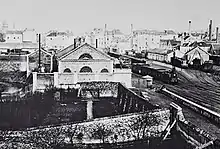
A first station known as Bogards' railway station (French: Gare des Bogards, Dutch: Bogaardenstation) had existed, since 1839, near the Place Rouppe/Rouppeplein in the southern part of the City of Brussels, so-called for the former cloister of the Bogards' convent whose site it was built on, and to which the Rue des Bogards/Bogaardenstraat is nowadays the only reference. This station, which quickly took the name "South Station" (French: Gare du Midi, Dutch: Zuidstation), served as the six-track terminus of the South Line, a southbound railway line linking Brussels to the industrial towns of Mons, Charleroi and La Louvière, at the heart of the Sillon industriel in Hainaut, Belgium, before crossing the French border (near Quiévrain), where a connecting line could reach Valenciennes, in northern France.[4] The former presence of a station at this location also explains the unusual width of the current Avenue de Stalingrad/Stalingradlaan, which goes up from the Place Rouppe to the Small Ring (Brussels' inner ring road), a reminder of the train tracks that used to run in its middle.[5]
Second station (1869–1949)
The Belgian railway network grew rapidly during the second half of the 19th century, becoming the densest in continental Europe. By then, Brussels-North and Brussels-South had become the primary railway stations in Brussels (Brussels-North slowly supplanted the original Allée Verte/Groendreef railway station near the same site). However, they were joined only by an inadequate single track running along what is today the Small Ring. Many proposals were put forward to link the two stations more substantially. A law was finally passed in 1909 mandating a direct connection; however, the final project would not be completed until nearly half a century later.
Around 1860, the South Station had reached saturation point and its location too close to the city centre began to cause problems, so the authorities decided to demolish it. A new monumental station, designed by the architect Auguste Payen in neoclassical style, opened in 1869, a short distance south from the original site, on the territory of the municipality of Saint-Gilles/Sint-Gillis.[5] The entrance was shaped like a triumphal arch, richly decorated with sculptures by Joseph Ducaju. In 1880, an allegorical statue of Nike, the Greek goddess of victory riding a chariot, by the sculptor Louis Samain, was placed on the roof of the station as a tribute to railway engineering.[3] In front of the station, a large public square, known as the Place de la Constitution/Grondwetplein ("Constitution Square"), was created, acting as an entry to the city for its many commuters.[5][6]
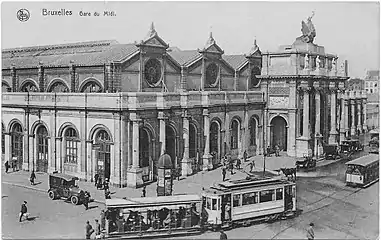 The second Brussels-South railway station (1869), pictured in 1927
The second Brussels-South railway station (1869), pictured in 1927 The second station's main facade and triumphal arch, c. 1920
The second station's main facade and triumphal arch, c. 1920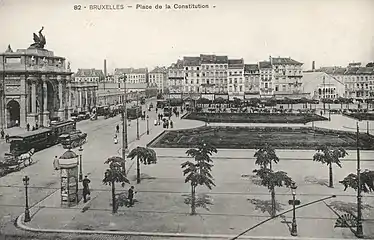 The Place de la Constitution/Grondwetplein in front of the second station
The Place de la Constitution/Grondwetplein in front of the second station
Current station (1949–present)
Payen's terminal station was itself demolished in 1949, as part of the North–South connection project, and replaced by a transit station on its present site along the Avenue Fonsny/Fonsnylaan. Most of the current buildings were erected between 1939 and 1954, in post-war functionalist style, from plans by architects Adrien and Yvan Blomme and Fernand Petit. Work on the connection also led to the station's immediate surroundings to be reorganised. The railway tracks were raised 6 metres (20 ft) and extended unto a viaduct towards the city centre, with shops under it and a covered street; the Rue Couverte/Bedektestraat (formerly the Rue de l'Argonne/Argonnestraat), along which trams run.[5]
Since the 1990s, the South Station and the district adjacent to it have undergone profound transformation. The rear part of the station, designed in 1992 by the architect Marc De Vreese, and built in front of the Place Victor Horta/Victor Hortaplein, serves as a terminal for high-speed trains. On Saint-Gilles' side, expropriation plans have led, since 2012, to the creation of modern office blocks constituting a tertiary economic sector along the Avenue Fonsny, as well as extensions of the station along the Rue de France/Frankrijkstraat, the two arteries that surround the station. This business centre located a stone's throw from the city centre, is intended, in the spirit of the public authorities, to mirror the Northern Quarter business district (also called Little Manhattan), located near the North Station, on the opposite side of the city centre.
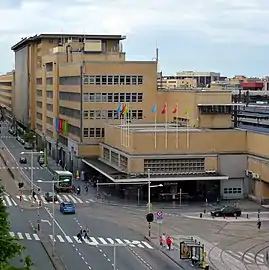 The third (current) Brussels-South station (1952) on Avenue Fonsny/Fonsnylaan
The third (current) Brussels-South station (1952) on Avenue Fonsny/Fonsnylaan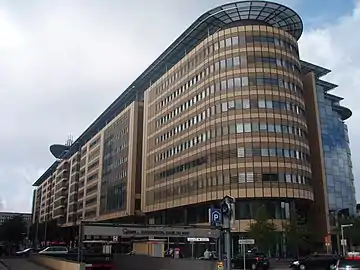 Terminal building (1992) on the Place Victor Horta/Victor Hortaplein
Terminal building (1992) on the Place Victor Horta/Victor Hortaplein Brussels-South railway station entrance
Brussels-South railway station entrance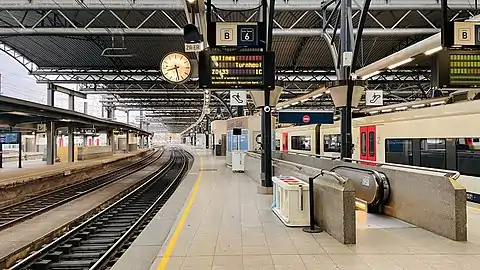 View of the South Station's platforms and tracks
View of the South Station's platforms and tracks
Features
The station is surrounded by the Avenue Fonsny/Fonsnylaan to the east, the Rue de France/Frankrijkstraat to the west, the Rue Couverte/Bedektestraat to the north and the Rue des Vétérinaires/Veeartsenstraat to the south. In the 1990s, the Eurostar terminal was added on the Rue de France's side. This part contains two bay platforms with no onward northbound connection.
A tripartite agreement was signed by Belgium, France and the UK on 15 May 1993, which permitted British officials to carry out pre-embarkation immigration controls for passengers travelling on direct Eurostar train services from Brussels to London and Belgian officials to carry out pre-embarkation immigration controls at London Waterloo International (and subsequently St Pancras International) station for passengers travelling in the other direction. As a result of this agreement, juxtaposed controls were set up in the station. On 1 October 2004, an administrative arrangement was signed by Belgium, France and the UK to extend juxtaposed controls to Eurostar services between London and Brussels which make a stop in Lille.[7]
Eurostar passengers travelling to the UK clear exit checks from the Schengen Area (carried out by the Belgian Federal Police) as well as UK entry checks (conducted by the UK Border Force) in the station before boarding their train. On the other hand, Eurostar passengers travelling to Lille Europe or Calais-Fréthun remain within the Schengen Area and are therefore not subject to border checks. Accordingly, they go through a different departure area in the station (bypassing the juxtaposed controls for passengers heading to the UK) and travel in a separate designated coach (available in standard class only) controlled by security guards, who ensure that all of these passengers disembark at Lille/Calais before the train continues to the UK.[8]
Train services
The station is served by the following services:[9]
- High speed services (Eurostar) London - Lille - Brussels
- High speed services (Eurostar) London - Brussels - Rotterdam - Amsterdam
- High speed services (Intercity Express) Brussels - Liège - Cologne - Frankfurt
- High speed services (Thalys) Amsterdam - Rotterdam - Antwerp - Brussels - Paris
- High speed services (Thalys) Dortmund - Essen - Düsseldorf - Cologne - Liège - Brussels - Paris
- High speed services (Thalys) Amsterdam - Rotterdam - Antwerp - Brussels - Lille
- High speed services (Thalys) Amsterdam - Rotterdam - Antwerp - Brussels - Chambéry - Bourg-Saint-Maurice (in winter)
- High speed services (Thalys) Amsterdam - Rotterdam - Antwerp - Brussels - Avignon - Marseille (in summer)
- High speed services (TGV) Brussels - Lille - Aéroport CDG - Lyon - Avignon - Marseille
- High speed services (TGV) Brussels - Lille - Aéroport CDG - Lyon - Nîmes - Montpellier - Perpignan
- High speed services (TGV) Brussels - Lille - Aéroport CDG - Strasbourg
- High speed services (ICD-35) Amsterdam - Rotterdam - Breda - Antwerp - Brussels Airport - Brussels
- Intercity services (IC-01) Ostend - Bruges - Ghent - Brussels - Leuven - Liège - Welkenraedt - Eupen
- Intercity services (IC-03) Blankenberge - Bruges - Ghent - Brussels - Leuven - Hasselt - Genk
- Intercity services (IC-16) Brussels - Namur - Arlon - Luxembourg
- Intercity services (IC-05) Essen - Antwerp - Mechelen - Brussels - Nivelles - Charleroi (weekdays)
- Intercity services (IC-06) Tournai - Ath - Halle - Brussels - Brussels Airport
- Intercity services (IC-06A) Mons - Braine-le-Comte - Brussels - Brussels Airport
- Intercity services (IC-07) Charleroi - Nivelles - Brussels - Antwerp (weekdays)
- Intercity services (IC-11) Binche - Braine-le-Comte - Halle - Brussels - Mechelen - Turnhout (weekdays)
- Intercity services (IC-11) Binche - Braine-le-Comte - Halle - Brussels - Scharbeek (weekends)
- Intercity services (IC-12) Kortrijk - Ghent - Brussels - Leuven - Liège - Welkenraedt (weekdays)
- Intercity services (IC-13) Kortrijk - Denderleeuw - Brussels - Schaarbeek (weekdays)
- Intercity services (IC-14) Quiévrain - Mons - Braine-le-Comte - Brussels - Leuven - Liège (weekdays)
- Intercity services (IC-16/34) Brussels - Namur - Arlon - Luxembourg
- Intercity services (IC-17) Brussels - Namur - Dinant (weekends)
- Intercity services (IC-18) Brussels - Namur - Liège (weekdays)
- Intercity services (IC-20) Ghent - Aalst - Brussels - Hasselt - Tongeren (weekdays)
- Intercity services (IC-20) Ghent - Aalst - Brussels - Dendermonde - Lokeren (weekends)
- Intercity services (IC-22) Antwerp - Mechelen - Brussels
- Intercity services (IC-23) Ostend - Bruges - Kortrijk - Zottegem - Brussels - Brussels Airport
- Intercity services (IC-23A) Knokke - Bruges - Ghent - Brussels - Brussels Airport
- Intercity services (IC-26) Kortrijk - Tournai - Halle - Brussels - Dendermonde - Lokeren - Sint Niklaas (weekdays)
- Intercity services (IC-29) Gent - Aalst - Brussels - Brussels Airport - Leuven - Landen (weekdays)
- Intercity services (IC-29) De Panne - Gent - Aalst - Brussels - Brussels Airport - Leuven - Landen (weekends)
- Intercity services (IC-31) Antwerp - Mechelen - Brussels (weekdays)
- Intercity services (IC-31) Antwerp - Mechelen - Brussels - Nivelles - Charleroi (weekends)
- Brussels RER services (S1) Antwerp - Mechelen - Brussels - Waterloo - Nivelles (weekdays)
- Brussels RER services (S1) Antwerp - Mechelen - Brussels (weekends)
- Brussels RER services (S1) Brussels - Waterloo - Nivelles (weekends)
- Brussels RER services (S2) Leuven - Brussels - Halle - Braine-le-Comte
- Brussels RER services (S3) Dendermonde - Brussels - Denderleeuw - Zottegem (weekdays)
- Brussels RER services (S3) Schaarbeek - Brussels - Denderleeuw - Zottegem (weekends)
- Brussels RER services (S6) Aalst - Denderleeuw - Geraardsbergen - Halle - Brussels - Schaarbeek (weekdays)
- Brussels RER services (S6) Denderleeuw - Geraardsbergen - Halle - Brussels - Schaarbeek (weekends)
- Brussels RER services (S8) Brussels - Etterbeek - Ottignies - Louvain-le-Neuve
- Brussels RER services (S10) Dendermonde - Brussels - Denderleeuw - Aalst
Metro and premetro station
.jpg.webp) Gare du Midi/Zuidstation metro station | |||||||||||||||
| General information | |||||||||||||||
| Owned by | STIB/MIVB | ||||||||||||||
| Connections | |||||||||||||||
| Construction | |||||||||||||||
| Structure type | Underground | ||||||||||||||
| History | |||||||||||||||
| Opened | 2 October 1988 | ||||||||||||||
| Services | |||||||||||||||
| |||||||||||||||
Brussels Premetro North-South Axis | ||||||||||||||||||||||||||||||||||||||||||||||||||||||||||||||||||||||||||||||||||||||||||||||||||||||||||||||||||||||||||||||||||||
|---|---|---|---|---|---|---|---|---|---|---|---|---|---|---|---|---|---|---|---|---|---|---|---|---|---|---|---|---|---|---|---|---|---|---|---|---|---|---|---|---|---|---|---|---|---|---|---|---|---|---|---|---|---|---|---|---|---|---|---|---|---|---|---|---|---|---|---|---|---|---|---|---|---|---|---|---|---|---|---|---|---|---|---|---|---|---|---|---|---|---|---|---|---|---|---|---|---|---|---|---|---|---|---|---|---|---|---|---|---|---|---|---|---|---|---|---|---|---|---|---|---|---|---|---|---|---|---|---|---|---|---|---|
| ||||||||||||||||||||||||||||||||||||||||||||||||||||||||||||||||||||||||||||||||||||||||||||||||||||||||||||||||||||||||||||||||||||
The metro station, called Gare du Midi/Zuidstation, opened on 2 October 1988 as (at that time) the terminus of metro line 2 from Simonis. Line 2 has since been extended beyond Brussels-South to Clemenceau in 1993, Delacroix in 2006, and Gare de l'Ouest/Weststation in 2009. Since 1993, the station also accommodates premetro (underground tram) services at separate platforms, with cross-platform interchange between metro and premetro in both directions.
Connections
International buses
Since 23 July 2012, SNCF's international coach network, OUIBUS (taken over by BlaBlaBus in 2018), has served Brussels-South.
- Paris - Lille - Brussels
- Amsterdam - Brussels (from 28 April 2014)
- Amsterdam - Brussels - London (from 28 April 2014)
Other bus services
A shuttle service to Brussels South Charleroi Airport leaves from a stop located on the Rue de France/Frankrijkstraat.[10]
Places of interest
The South Tower, the tallest building in Belgium,[11] stands in front of the station's main exit (the crossroad of the Avenue Fonsny/Fonsnylaan and the Rue Couverte/Bedektestraat) and houses the Belgian Federal Pensions Service (FPS).[12]
See also
References
Notes
- Lyons, Declan (18 February 2009). Cycling guide to the Canal du Midi, Languedoc, France, Europe. Midpoint Trade Books. ISBN 978-1-85284-559-9.
- Passy, Paul (1904). International French–English and English–French dictionary. Hinds, Noble & Eldredge.
- focusonbelgium.be
- Dambly, 1989, p. 6–7
- "A history of the development of the Gare du Midi district". be.midi. Retrieved 28 June 2020.
- "Saint-Gilles - Place de la Constitution". www.irismonument.be. Retrieved 28 June 2020.
- "Explanatory Memorandum to the Channel Tunnel (Miscellaneous Provisions) (Amendment) Order 2004 No. 2589" (PDF). Home Office.
- "Conditions of Carriage". Eurostar. 4 February 2019. Archived from the original on 27 March 2020. Retrieved 28 March 2020.
For security and border control reasons, any booking for intra-Schengen travel from Brussels to Lille or Calais is available in Standard class only and limited to coach 18 or 16 (the "Dedicated Coach"), depending on the type of train. Intra-Schengen passengers departing from Brussels are not subject to border controls, whether for exiting Schengen area or entering the United Kingdom. Therefore, any movement by any intra-Schengen passenger to and from the Dedicated Coach between Brussels and Lille or Calais will be strictly limited and controlled. You must cooperate with our on-board staff and agents, as well as security and border control authorities in the stations in relation to these requirements. Any failure to cooperate, any non-authorised movement to and from the Dedicated Coach and/or any refusal from any intra-Schengen passenger to get off the train at Lille or Calais may result in the intervention of security and border authorities
- "SNCB/NMBS timetable leaflets".
- Brussels City-Charleroi airport shuttle bus service
- GmbH, Emporis. "Belgium | Statistics | EMPORIS". www.emporis.com. Archived from the original on 11 May 2015. Retrieved 23 March 2018.
- "SFPD". www.sfpd.fgov.be. Retrieved 23 March 2018.
Bibliography
- Dambly, Phil (1989). Vapeur en Belgique [Steam in Belgium]. Vol. Tome 1: Des origines à 1914 [Volume 1: Origins to 1914]. Brussels: G. Blanchart & Cie. ISBN 2872020055. (in French)
- Dambly, Phil (1994). Vapeur en Belgique [Steam in Belgium]. Vol. Tome 2: De 1914 aux dernières fumées [Volume 2: From 1914 to last smoke]. Brussels: G. Blanchart & Cie. ISBN 2872020136. (in French)
- Wolmar, Christian (2010). Blood, Iron & Gold: How the Railways transformed the World. London: Grove Atlantic. ISBN 978-1-84887-171-7.
External links
![]() Media related to Brussels Midi station at Wikimedia Commons
Media related to Brussels Midi station at Wikimedia Commons
